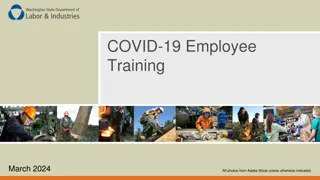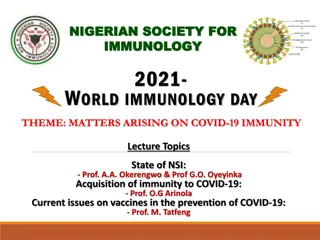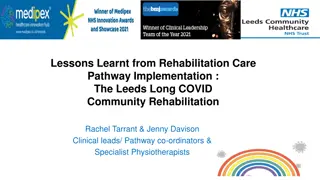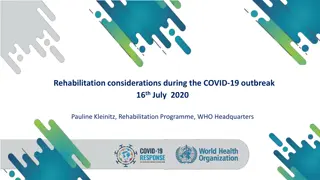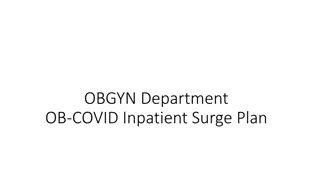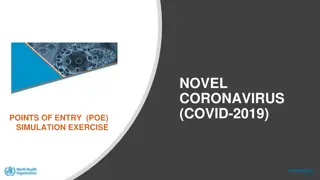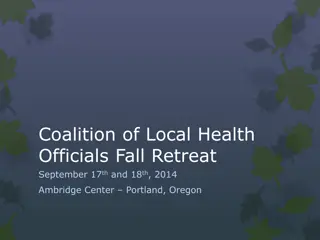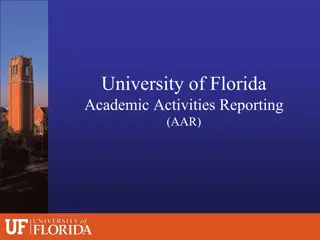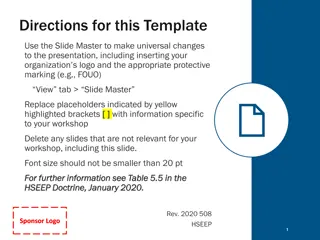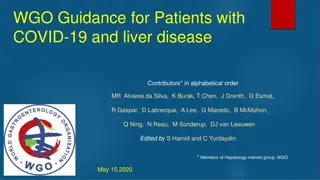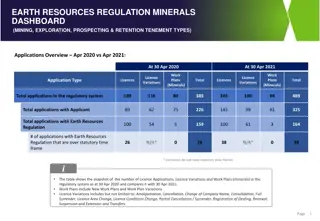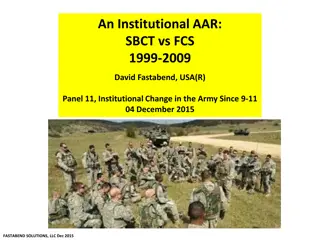
Oregon COVID-19 After Action Review Highlights
Explore the Oregon Executive Branch's comprehensive after-action review of its COVID-19 response, detailing key findings and decision timelines. The review covers various aspects such as PPE, state response phases, Joint Information Centers, and the ongoing vaccination campaign. Dive into the in-depth analysis and evaluation of Oregon's handling of the pandemic.
Download Presentation

Please find below an Image/Link to download the presentation.
The content on the website is provided AS IS for your information and personal use only. It may not be sold, licensed, or shared on other websites without obtaining consent from the author. If you encounter any issues during the download, it is possible that the publisher has removed the file from their server.
You are allowed to download the files provided on this website for personal or commercial use, subject to the condition that they are used lawfully. All files are the property of their respective owners.
The content on the website is provided AS IS for your information and personal use only. It may not be sold, licensed, or shared on other websites without obtaining consent from the author.
E N D
Presentation Transcript
STATE OF OREGON ~ EXECUTIVE BRANCH COVID-19 AFTER ACTION REVIEW'S M.K. Harryman, MA State Resilience Officer Last update: 12 April 2021
OREGON COVID-19 AAR (JAN-MAY 2020) Price Agreement between DAS and EM Partners (vendor) 12-month retainer, started in June 2020 To date we have established four Service Order Contracts (SOC) EM Partners will use the following tools to collect data: Survey core groups: Agencies City, county and tribal EM s and LHD s Hospitals and healthcare organizations Long Term Care Facilities Incident Management Team key personnel Interviews of individuals and work groups (to include private sector) Review of all Incident Action Plans (IAPs) from: AOC, ECC and IMTs Review best practices
LIST OF ORGANIZATIONS GETTING SURVEYED Governor s Office Oregon Emergency Response Agencies Coronavirus Response Team Tribes: Health and EM staff DAS-ESF 7 Response Team CBO: Homelessness OEM ODOC-Warehouse and PPE CBO: Migrant Farmworkers / Food Producers Region X FEMA/HHS OR Emergency Management Association Hospitals Local PH and EM Long Term Care Facilities
OREGON COVID-19 AAR Three of SOC s are running concurrently but have separate due dates SOC #1 Review of Personal Protective Equipment (PPE) Establishing: survey groups/listing/questions Completed Final Draft and Executive Summary September 2020 and Final Report 12 April 2021 SOC #2 Oregon s response to COVID-19 Phase 1 Initial State Response Phase 2 Enterprise Mobilization Completed Final Draft October 2020 and Final Report - April 2021 SOC #3 State s Joint Information Centers Completed Final Draft December and Final Report April 2021 SOC #4 Re-opening phase from 1 June to 30 Nov 2020 Currently is ongoing *Amended 10 Dec 2020, pending final draft April 2021 SOC#5 Vaccination Campaign Currently being put together with DAS and the vendor, 15 Dec 30 June
OREGON COVID-19 AAR SOC #1 KEY DECISION TIMELINE
OREGON COVID-19 AAR SOC #1 KEY FINDINGS Areas of Success Preparedness Training and Exercises Executive leadership and agency-specific training and exercises increased competency in and engagement in response decision-making. Initial Response OHA acted in response to a health intelligence briefing in January recognizing the rising risk of a pandemic by standing up the incident management team, allowing Oregon to lean into preparations for response. Executive Collaboration The Governor quickly established the Coronavirus Response Team (CRT) to engage agency directors in the evaluation of situational information and response actions to determine priorities for the state. Incident Management Teams Integration of IMT teams helped the CRT/Multi-Agency Coordination (MAC) group, OHA and OEM coordinate and transition from an agency focused response to an enterprise response. Relationship with Partners Relationships with HHS partners assisted with the initial response to and the distribution of the warehoused PPE. As the sourcing and procuring effort grew, partnerships between FEMA and the private sector yielded good results. ESF 7 Problem-solving Mindset Strong executive leadership and flexibility allowed DAS to embrace common day-to-day practices, adjust operations as the situation required, and engage team members to get the work done. Situational Assessment Operational Coordination
OREGON COVID-19 AAR SOC #2 KEY DECISION TIMELINE
OREGON COVID-19 AAR SOC #2 KEY FINDINGS Areas of Success Planning Comprehensive Emergency Management Program The program includes a suite of plans, including a hazard mitigation plan, preparedness plan, emergency operations plan and a recovery plan. Training and Exercises The Governor s Disaster Cabinet (GDC) Exercises in 2018 and 2019 created a sense of buy-in for disaster work across state agencies. Situational Assessment Initial Public Health Response OHA activated emergency operations on January 21 following a health intelligence briefing. Soon after the OHA IMT stood up and began augmenting public health personnel with staff from across OHA and other agencies as response operations grew. Executive Leadership OHA worked very closely with the Governor and her team, providing the best information and guidance possible to assist with executive decision-making. Agency Engagement The governor was well prepared to address this event. GDC and Economic Recovery EO 16-07 were established. The state agencies faced new challenges and were able to quickly adjust to overcome. Environmental Response/Health & Safety Public Health Guided Decisions The Governor s Executive Orders provided instructions to protect the health and safety of Oregonians.
OREGON COVID-19 AAR SOC #3 KEY DECISION TIMELINE
OREGON COVID-19 AAR SOC #3 KEY FINDINGS Areas of Success Preparedness Communications Plans Exist The High Impact Pathogen Plan of Operations (HIPPO), ESF 8 Base Plan External Affairs Annex and the state s Emergency Operations Plan ESF 14 all outline public information and communication plans with Joint Information Center activation triggers, communication strategies, and roles and responsibilities. Public Information and Warning Translated and Interpreted Messaging OHA has established mechanisms to facilitate translation of materials into multiple languages. This is a standard practice, so it was not a unique task to ensure materials were available in different languages. Consistently having a sign language interpreter at broadcast events supported communication to those who are deaf or hearing impaired. Operational Coordination Governor s Office and OHA JIC Collaboration The Governor s Office and OHA collaborated closely on the COVID-19 response. This close relationship facilitated effective communication about the Governor s decisions and public health protective measures.
POINT OF CONTACT Mike Harryman, MA State Resilience Officer Office of Governor Kate Brown mike.k.harryman@oregon.gov | 503.975.1911 cell

